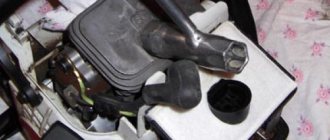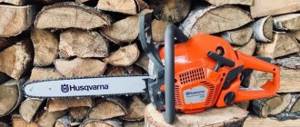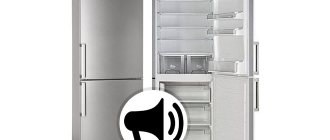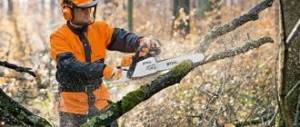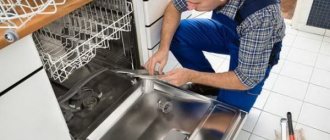Even professional chainsaws from world-famous manufacturers break down - no one is immune from this. The question is how often breakdowns occur and how serious they are. It’s one thing when you need to sharpen the chain or replace the drive sprocket, and another thing when the chainsaw doesn’t start or shoots into the carburetor. In fact, most of the problems can be fixed with your own hands, for example, when the chainsaw does not lubricate the chain or stalls.
No. 1. Chainsaw won't start
If difficulties arise with starting a chainsaw, many immediately blame the carburetor. In fact, there are several options and the cause of the malfunction can be any:
- Air and/or fuel filters are clogged. The problem can be solved by cleaning the filters.
- Lack of fuel in the tank. Yes, there is such a reason - some owners forget about such an insignificant detail as refueling a chainsaw and think that a couple of liters of gasoline will last for six months. In addition, fuel in the tank should not be stored for more than 14 days, because gasoline evaporates and the octane number is lost.
- Check the pipe from the fuel tank to the carburetor - it could be clogged or broken, so gasoline does not flow into the tank.
- There is no spark at the spark plug. Why there is no spark - there can be many reasons: there is no contact, the spark plug needs to be changed or it is flooded. Why the spark plug on a chainsaw fills is another question. But if this happens, you need to dry it and reinstall it, and then check for a spark. If there is heavy carbon deposits on the spark plug, it is recommended to replace it.
- Check the muffler for carbon deposits. If there is carbon deposits, thoroughly clean the muffler, but it is still recommended to take the chainsaw to a service center to have the cylinder and piston checked, because carbon deposits are a sure sign of improper operation of the elements of the cylinder-piston group.
- The carburetor is clogged. How to properly adjust a chainsaw so that the carburetor works well is discussed in a separate article.
If none of the above methods helped, then the reason is more serious - a breakdown of one of the connecting rod-piston group units. In this case, it is recommended to take the chainsaw to a service center.
Why does a chainsaw start and stop immediately?
The chainsaw starts and immediately forgets; the reason for this behavior can be hidden in the carburetor. A faulty fuel pump or malfunction of the main fuel jet can cause this behavior of the saw. The inability to operate the chainsaw after starting requires a full diagnosis at a service center.
READ Chainsaw Champion Starts and Stalls Cause
All of the above options for engine malfunction have similar causes, which, depending on their negligence, can have different manifestations. For example, if a little air is sucked into the crankcase, its operation will not change much, the engine power will decrease slightly, the maximum speed will increase, and it will be able to warm up a little. In the middle stages of an air leak, the engine will stall at idle and become very hot during operation. A severe air leak will make the saw impossible to operate, it will immediately start and stop.
In parallel with visible manifestations of malfunctions, such as the inoperability of the chainsaw after starting, processes will occur inside the engine during its failure that irreversibly lead the saw to the most serious consequences, such as melting of the piston, jamming of the crankshaft.
No. 2. The engine stalls
The engine starts, but the chainsaw stalls at idle or under load. In this case, most often you should perform the same actions as described above.
How to adjust a chainsaw depends on exactly when the problems start:
Stalls immediately after starting:
- The fuel mixture is not prepared correctly, there is too much oil in it, so the octane number of gasoline is less than it should be, so the chainsaw only runs on choke or stalls immediately.
- Carbon deposits on the spark plug or improper gap between the spark plug and the wire.
It stalls and does not work at idle:
- The muffler is clogged. It is necessary to remove carbon deposits.
- The carburetor settings are off. The idle speed on the chainsaw needs to be adjusted. This is done using adjusting bolts marked L and H. For how to adjust idle speed, see the article about adjusting the carburetor.
Stalls at maximum speed and only runs on choke
- The air or fuel filter is clogged. The seals need to be cleaned and checked.
- The breather is clogged and because of this, fuel does not flow and pumping gasoline on the chainsaw does not work. Take the needle and carefully clean the breather.
- Fuel pump malfunction. Remove the pump and check to see if gasoline is leaking from it. If it oozes, replace the sealing gasket or the pump itself.
The chainsaw does not cut under load and stalls
- The air filter is clogged. It is necessary to take out the filter, clean it well or even rinse it, dry it and install it back.
- Wrong proportion of oil/gasoline mixture. Drain the fuel and remix the oil and gasoline in the correct proportions.
The chainsaw is getting hot, what is the reason?
Content
For what reasons does a chainsaw start and not stall?
The introduction of a chainsaw simplifies difficult work. But when the chainsaw starts, it doesn’t stall, the reason
This is for you at least. What to do? You need to choose: take it to the workshop to specialists, as they also call it, and try to repair it with your employees. We will try to help the reader understand the reasons for the failure, methods for eliminating breakdowns, and we will not give advice on operating chainsaws. Next, it is useful for the owner to find out what remains to be done by our client about the factory instruction manual and the design features of his own chainsaw. This information will help him to use it well and repair the instrument skillfully.
Circuit diagram of a chainsaw.
Characteristics of the internal combustion engine of chainsaws
The main malfunctions of chainsaws are associated with engine failures. To drive the chain, Russian and foreign Russian manufacturers use single-cylinder two-stroke internal combustion engines. The design of the motor is ordinary. Ignition is ordinary, without installing capricious electronics. Chainsaw engines work well in different climate conditions. Fuel for a carburetor engine is obtained by mixing AI-92 gasoline and special oil. Because the design does not include an oil pump, the piston and cylinder are lubricated with a mixture of gasoline and oil. The saw engine develops power from two to 5 kW, and the crankshaft speed reaches fourteen thousand rpm. At such high speeds and loads, the requirements for oil are special. Use the oil indicated in the instructions. When changing the oil to regular motor oil, the tool's service life is sharply reduced. Remember that filling the tank with gasoline without adding oil is strictly prohibited.
Tools and materials
Diagram of a two-stroke chainsaw engine.
READ How to Cut Chipboard Without Chips
The design of mechanical components of chainsaws is characterized by good reliability and maintainability. Almost all units and parts have free access. If the necessary equipment is available, they can be easily removed for repair or replacement. To disassemble and check the life support systems of a chainsaw engine, you should stock up on the following tools and materials:
- a set of plumbing and assembly tools;
- socket wrench;
- tester;
- pressure gauge for measuring compression;
- probes for measuring gaps;
- needle;
- sandpaper;
- fuel mixture (gasoline oil);
- rags.
Classification of engine faults
Before starting the chainsaw, it is necessary to check the condition of the saw part and fill the fuel and oil tanks. After checking, proceed to launch. If deviations or malfunctions in the drive operation occur, it is necessary to carefully inspect the saw motor. As a result of an external inspection, make sure that all components are complete and intact, that there are no mechanical damages, or any gasoline or oil leaks. Let us point out the main malfunctions associated with poor engine performance:
Chainsaw fuel system.
- The engine does not start.
- It starts, but soon the chainsaw stalls.
- It works unstable.
- Stops functioning under load.
- Loses its power.
Eliminating overheating on a chainsaw
For the sake of experimentation, tests are still to be continued.
Engine troubleshooting is carried out in the following main directions:
- failure of the ignition system;
- failures in the fuel supply system;
- piston group malfunction.
Saw mechanisms require constant care, preventative maintenance and repairs.
Knowledge of the operating principle of a two-stroke gasoline engine will help the operator independently determine the cause of the failure and quickly restore the operation of the chainsaw.
Troubleshooting yourself
If it is impossible to start the engine, it is necessary, observing the order, to perform the following actions:
Location of the air filter and spark plug.
- Check the presence of gasoline in the tank.
- Replace fuel if it has been stored for more than a month.
- Check the fuel filter. Disconnect the hose from the carburetor and observe the stream that flows out. If gasoline flows freely, the fuel filter is not clogged. If the flow rate is insufficient, clean the hole in the tank cap or filter.
- Clean the air filter . The air filter
can be removed for a test run - Inspect and clean the muffler from burning.
- Check the functionality of the launcher. If necessary, repair the starter (replace the pulley, spring or cable).
- Disassemble and clean the clogged carburetor.
- Test the high-voltage wire with a tester to ensure there is no break.
- Measure the gap between the flywheel magnets and the ignition module (should be 0.2 mm).
- Unscrew the spark plug and inspect it. Measure the gap between the electrodes with a feeler gauge (normally 0.5-0.6 mm). Based on the appearance of the electrodes, we determine the nature of the malfunction. If the spark plug is dry, there is no supply of working mixture. A working part flooded with gasoline indicates poor carburetor adjustment or lack of spark. To check for spark, connect the high voltage tip to the spark plug, place the skirt on the cylinder radiator and pull the starter cord. If there is no discharge between the electrodes, the spark plug must be replaced. The formation of carbon deposits on the electrodes indicates a poor quality of the fuel mixture. The central and side electrodes should be cleaned with sandpaper.
- No compression. The reason is failure of the piston group . Measure compression. First you need to unscrew the spark plug. Then insert the pressure gauge into the cylinder bore and use the starter cord to move the piston. piston group
(CPG) is judged by the pressure in the cylinder It must be at least eight atm. Low performance is caused by wear of the cylinder, piston, and piston rings.
READ Chainsaw Shoots Silencer
What should I do if the engine stalls after starting?
Diagram of the interaction of fuel and air flow in a chainsaw carburetor.
We often observe that the saw does not operate for long after starting - the chainsaw stalls almost immediately. This malfunction has characteristic symptoms. The list shows the probable causes of the malfunction and how to eliminate it:
- Lack or low volume of fuel. If a failure occurs when sawing in an inclined position, this indicates that the intake tube is rising above the fuel level. Check for fuel in the tank. Fill with gasoline to the required level.
- Poor quality fuel mixture. Prepare fuel in strict accordance with the saw manufacturer's instructions. Replace the mixture completely.
- The breather is clogged. Low fuel consumption to the engine. Breather is a breathing hole in the tank cap. Clear the clog with a needle.
- Poor contact of the spark plug with the high-voltage wire cap. In this case, the porcelain insulator of the candle gets very hot. Clean the contact and fit the cradle tightly onto the spark plug.
- Spark plug faulty. Replace with a new one or a known good one.
- The muffler is clogged with combustion products (exhaust gas). The muffler needs to be cleaned.
- The carburetor is not adjusted. To adjust the quality of the mixture, the carburetor has three screws: “L”—fine adjustment, “H”—coarse adjustment at high speeds, and “T”—adjustment at idle speed. By observing the sequence of adjusting the screws, we achieve higher crankshaft speeds.
- The air filter is clogged . Air enters the carburetor in small quantities - we get an enriched mixture. The saw stalls as the load increases when cutting hardwood and large diameter trunks. Rinse the filter in warm water and dry.
- Failure of the piston group. Replace defective parts.
READ What You Can Do With a Miter Saw
Now you can independently find and eliminate the reasons why chainsaws start and stall, the reasons why they stop. Recall that the chainsaw
develops high speed of movement of the working body (chain) and is considered a dangerous cutting tool. Strictly follow safety rules when performing work, servicing and repairing the chainsaw.
Source
No. 3. The engine "shoots"
If during operation there are extraneous sounds similar to gunshots, then there is a problem with the muffler or carburetor. How to make a chainsaw run quietly? It depends on which node is faulty.
Shoots the carburetor:
- Ignition is too late - the air-fuel mixture does not have time to burn out in the cylinder, so the sound is similar to a small explosion.
- Lean air-fuel mixture. Too little gasoline enters the mixture - the chainsaw, or rather the jets, needs to be adjusted to increase the fuel supply. Why the chainsaw revs on its own is for the same reason.
Shoots at the silencer:
- Enriched air-fuel mixture. Why does a chainsaw “shoot”? There is too much gasoline and not enough air in the mixture, so the mixture does not completely burn out in the chamber and partially burns out in the muffler. Carbon deposits on the exhaust are a clear sign of this. The air filter needs to be cleaned or the carburetor adjusted.
Summarize
At the first sign of a chainsaw malfunction, it is necessary to carry out a full diagnosis. To avoid damage to your saw due to improper maintenance, it is best to leave the job of identifying and repairing engine problems to professionals. And most importantly, you don't want to use a chainsaw with minor defects because it will lead to even bigger problems.
Source
There are several simple rules for operating and maintaining chainsaws, the observance of which will increase their service life. Preparing the correct fuel mixture, regularly cleaning filters and periodically replacing parts will save you from having to repair the tool for a long time. If it is impossible to avoid a breakdown, you can find out the cause yourself. This applies to all brands of chainsaws, from the more complex Husqvarna and Stihl models to the simplest Makita and Patriot models.
Chainsaws immediately
What to do if immediately after starting the chainsaw? First you need to check the fuel in the gas tank. If its level is insufficient, the fuel mixture must be prepared in strict accordance with the ratio of gasoline and oil specified in the operating instructions. Gasoline must have the highest possible octane number, and the required brand of oil is usually indicated in the chainsaw's passport.
Next, check the spark plug, as well as the contact of its tip with the high-voltage wire. The gap between them should be no more than 0.5 mm. If necessary, the candle is cleaned of carbon deposits and dried. It is recommended to periodically replace the spark plug with a new one. The reasons why the tool stops when you press the gas are hidden in the fuel filter or carburetor jet. Cleaning the gas filter will not take much time and effort, but it is better to entrust disassembly and cleaning of the carburetor to service center specialists.
READ Carburetor Adjustment for Chainsaw Shtil MS 660
Chainsaw chains idling
It is common to see a chainsaw idling. First of all, you should check the muffler and, if it is dirty, clean it of any resin deposits. Also on the carburetors of some models and others there are bolts marked H and L - respectively, rough and fine installation. By adjusting the L bolt while the chainsaw is running to increase its speed (turning the bolt only half a turn), you can solve this problem. Adjusting the carburetor requires an electronic tachometer and is a rather labor-intensive process. That is why in such cases it is better to turn to professionals.
Chainsaws during loading
If the chainsaw is under load, the cause may be the fuel system or a dirty air filter. Changing the fuel to the correct gas/oil ratio or cleaning the air filter are universal solutions to this problem. An incorrectly prepared mixture of low-quality gasoline and, for example, motor oil is the main reason for the failure of a chainsaw, including when it heats up and lags.
Chainsaws at tilt
When the chainsaw is positioned horizontally, the fuel pipe lies at the bottom of the fuel tank; when the tool is tilted, the pipe is above the fuel mixture, that is, in the air. This is why the chainsaw stands on its side.
No. 4. Chainsaw overheating
Why does the chainsaw get hot? The engine or tire may overheat - in any case, the fault is due to a small amount of lubricant.
- Engine overheating. The proportion of the fuel mixture is incorrect or pure gasoline is poured. Drain the fuel and make a mixture using the correct proportions of oil and gasoline, as specified by the manufacturer.
- Tire overheating. The oil pump needs to be cleaned or adjusted because... No oil is supplied to the tire.
No. 6. The chainsaw cuts to the side
When cutting, you may notice that the result is an uneven cut. Why does a chainsaw cut crookedly? There are several reasons:
- Incorrect chain sharpening. The teeth are sharpened at the wrong angle or only in one direction. Proper sharpening is required.
- Incorrectly selected chain. At very high speeds, a difference of even 0.2-0.3 mm between the width of the groove or the width of the seat will be visible, which is why the chainsaw cuts to the side. An appropriate circuit must be installed.
- Uneven tire wear. Over time, the tire wears out on one side and then the chain pulls to the side. Rotate the tire regularly to ensure even wear on both sides. If the wear is excessive, replace the tire.
No. 7. Chain lubrication problems
For normal operation, the chain must be constantly lubricated to reduce friction between the bar and the links, and also to prevent premature wear of the links.
- If the chain on the chainsaw is not lubricated, then there is a problem with the oil pump - oil is not supplied due to a clogged channel. Lack of lubrication is the reason why the chain stretches or why the chain breaks. Clean the channels; tiny particles of chips constantly get there and clog them. The oil hose may also break. If you need to adjust the chainsaw oil pump or repair it, it is better to contact a service center.
- Oil splashes from the chain. Incorrectly selected lubricant - it is too liquid, so it does not so much lubricate the links as it splashes onto the wood. Replace the lubricant with a thicker one.
Why is the chainsaw under load?
In some cases, a chainsaw under load cannot work properly and simply lags. A common cause of this behavior is improper carburetor adjustment or air flow through the crankshaft seal or carburetor gasket. And this behavior can occur due to a carburetor leak.
A saw that cannot operate under load will also oscillate to maintain idle speed. They will "float". Diagnostics begins with checking the tightness of the crankcase and carburetor. If air leaks are found at the crankshaft seals, they must be replaced. If an air leak is found in the carburetor, the cause can be corrected by installing a gasket repair kit.
Only after completing the above steps and sealing the engine crankcase with the carburetor can you begin to adjust the carburetor.
The reason for this algorithm is that if the air supply from the crankcase was not eliminated and the carburetor was simply adjusted prior to normal engine operation, the fuel mixture will contain more fuel than required for a sealed crankcase, which in turn will significantly increase its consumption. In addition, soot may appear in the engine, which will also negatively affect the further operation of the chainsaw.
READ Chainsaw Ural Starts and Stalls Cause
In some models of chainsaws, to ensure the operation of the fuel pump, special hoses are provided that transmit an air impulse from the crankcase to the carburetor fuel pump. If this hose is damaged, the saw will sit idle and not work at all under load.
You can watch the video below on how to replace a failed DIY impulse hose on a HUSQVARNA 142 chainsaw. He took the saw apart step by step, showed the impulse hose, and discussed the consequences of a failed HUSQVARNA 142.
No. 8. The chain falls off
Why does the chain fall off the tire? There may be several reasons and they are all different:
- Worn drive or driven sprocket. Due to the fact that the sprocket is worn out, the grip on the chain decreases, which is why the chain flies off the chainsaw. The sprocket needs to be replaced.
- The chain has stretched. Why the chain on a chainsaw stretches is due to insufficient lubrication. The metal heats up and stretches, even by a fraction of a millimeter, but if you take into account the number of links, then even 3-4 mm is enough for the chain to fly off the bar. The chain needs to be replaced.
- The chain tensioner that regulates its tension has become loose. how to regulate a chainsaw, or rather the chain tension? You need to adjust the tensioner - this can be done in just a few minutes.
No. 9. The chain does not rotate
Why doesn't the chainsaw chain rotate when the engine is running even at full speed?
- Leading sprocket. Either it is jammed, or the crown is worn out so much that it does not engage and the chain does not spin on the chainsaw. In any case, it is necessary to disassemble the sprocket to find out the exact reason why the chain does not spin. If the crown is worn out, it is necessary to replace the sprocket (or the crown itself, if the sprocket has a prefabricated structure).
- The chain brake is stuck. As a result, the sprocket is blocked by the brake mechanism, while the motor runs. It is necessary to turn off the engine and release the brake. If this happens under load, the brake mechanism will have to be changed, as well as the sprocket, because Due to the high temperature, many elements can melt and overheat.
Chinese and new chainsaw does not start, what could it be?
The popularity of Chinese chainsaws knows no bounds. This is due to their main advantage - affordable cost. At the same time, owners of Chinese chainsaws often have questions about problems starting the engine of the tool. Before you find out why a Chinese chainsaw won’t start, you should note one feature - the design of these tools is no different from Russian, German and other manufacturers. That is why the reason why the chainsaw does not start can be detected based on the algorithm described above.
Chinese chainsaws are very sensitive to fuel quality, so in the diagnostic algorithm, checking fuel quality comes first. The use of low-quality fuel leads to the fact that the tool does not work at full capacity, its service life is reduced, and difficulties arise with starting. The instructions for the tool indicate the recommended type of gasoline and oil, which are important to use in order for the Chinese chainsaw to work for a long time and at full power.
If you bought a new chainsaw and it does not start, then troubleshooting should begin by returning the tool to the store. Make sure that you start the engine of the tool correctly, and if you cannot achieve a positive result, then you need to return the tool to the store under warranty. Attempting to troubleshoot the problem yourself will leave traces and may void the warranty.
It is recommended to double-check that the fuel mixture is prepared correctly. If everything is done correctly, but the engine of a gasoline tool does not start, then there is a high probability of a manufacturing defect. There can be a defect with any part, but this should already be determined in the store’s service center.
No. 10. Chain brake does not work
All chainsaws are equipped with a main and inertial (emergency) brake. The latter turns on only when a backfire occurs. The main brake is designed to stop the chain while the engine is running. Why does the chain on the chainsaw jam and it doesn’t stop? Option two:
- The brake band is badly worn and does not provide sufficient stopping effect. The brake band needs to be replaced.
- Contamination of the tape. When working, debris may become clogged in the under-cover space: shavings, sawdust, dirt, etc. Debris is blocking the brake mechanism, so if the brake does not work, you need to clean the brake mechanism.
Why does a chainsaw get very hot?
DIY chainsaw repair and service
Prices for chainsaws are falling and this makes them more popular and accessible not only to experts, but also to ordinary, so to speak, amateurs. But it's a widespread addiction. the lower the cost, the less reliable the device and the more often malfunctions occur; this is also a problem for chainsaws. But for a chainsaw of any price range, most defects can be avoided with proper operation, care and timely maintenance of the equipment. But no one is insured against the breakdown of a chainsaw, as well as any other equipment. Therefore, it is proposed to consider the main types of chainsaw malfunctions, methods for diagnosing, eliminating and repairing them .
All the main malfunctions of chainsaws can be divided into two main categories: - malfunctions of the engine and its various components: fuel preparation and supply system, ignition, piston group with crankshaft, exhaust gas exhaust system; — malfunctions and breakdowns of other components: lubrication system, clutch, chain brake, tire and others.
Chainsaw engine malfunctions
Here are various malfunctions in the operation of a chainsaw engine that occur most often. These main malfunctions boil down to the following symptoms:
the engine does not start (quite general and the reasons can be quite different);
starts, but often stalls;
does not develop power, i.e. It runs normally at idle, but stalls or “boils” under load.
It smokes a lot and the power drops.
Problems starting the engine
It is very important to correctly determine the cause of the malfunction, because otherwise we simply cannot eliminate it. If, when trying to start the chainsaw, there are no extraneous sounds (knocking, grinding, etc.), then very often it turns out that in fact there is no breakdown. For example, if you start the chainsaw incorrectly and pull the choke for a long time, the engine simply floods and it is very difficult to start it.
In order to properly start a cold chainsaw engine, set the lever or switch to the “damper closed” position. Then you need to pump the mixture into the carburetor, if there is a fuel priming pump. Pull out the starting handle until the engine resistance becomes noticeable, and vigorously pull in amplitude, moving your hand to the side. After two. After three such movements, the engine should first start and then stall. If this does not happen, then you need to move the lever to the half-throttle position or simply to the working position and then continue to start the chainsaw in this mode. For many chainsaws, the “half throttle” is automatically locked when the air damper is pulled out. Some models have a key ignition switch; it is important to make sure it is turned on.
If the engine does not start, then the first thing to do is unscrew and inspect the spark plug. There are cases when at a plant in the cold season, the combustion chamber is filled with fuel. Then you also need to unscrew the spark plug, dry the combustion chamber by idling, clean the spark plug, screw it in and repeat the start. It is advisable to immediately check for the presence of a spark. We put a cap with a high-voltage wire on the unscrewed spark plug, place it on the cylinder and pull the starter. Visually we observe a frequent blue spark. Fine. Screw the spark plug into place and start it. If there is no spark, change the spark plug and try again. Not again. We check the connection of the high-voltage wire to the spark plug, the coil and the ignition system.
READ Chainsaw Shtil Which Gasoline 92 Or 95
In general, the type of malfunction can be judged by the condition of the spark plug.
- Dry. Most likely, the fuel mixture is not getting into the cylinder. The problem is not in the ignition system, so screw the spark plug back in and check the fuel supply system.
- Wet, heavily splashed with fuel. The reason for the excess fuel mixture lies either in a violation of the starting rules, as described above, or in incorrect carburetor adjustment.
- Covered with black soot. This may indicate the use of low-quality oil, an incorrectly adjusted carburetor, or an incorrectly calculated ratio of gasoline to oil. The spark plug should be washed, removed from carbon deposits with a sharp object (an awl or a needle), the electrodes should be wiped with sandpaper and placed in place.
When checking the spark plug, you need to pay attention to the gap between the electrodes: 0.5 to 0.65 mm is considered normal. A damaged or worn gasket must be replaced.
Checking and adjusting the chainsaw carburetor
A properly adjusted chainsaw carburetor ensures that it operates efficiently at full power with the most economical fuel consumption.
The need to adjust the carburetor of a chainsaw rarely arises, since the adjustment is initially carried out by the manufacturer to achieve optimal operating mode. The adjusting screws are designed for more precise adjustment of the chainsaw carburetor if necessary.
When and why does this need arise?
Among the reasons for the failure of fixation of the adjusting screws, the most common are the following:
- Severe vibration or damage to the protective cap. This happens rarely, but it does happen.
- Serious engine wear (piston). Of course, in this case it is worth taking more care of repairing the chainsaw engine, but still adjusting the carburetor can improve its functionality for a while.
- Blockage in the carburetor due to damage to the air filter, poor quality gasoline or due to the formation of scale. In this case, in addition to adjusting the carburetor, flushing it cannot be avoided.
Eliminating overheating on a chainsaw
For the sake of experimentation, tests are still to be continued.
Chainsaw won't start when hot
Chainsaw won't start
for hot.
What signs indicate the need to adjust a chainsaw carburetor?
- Firstly, the engine does not start, or it starts, but immediately stalls. This most often occurs due to a lean fuel mixture.
- Secondly, a significant increase in fuel consumption and exhaust emissions. An increase in exhaust emissions indicates that the fuel does not burn completely, which means that the cause may be oversaturation of the fuel mixture.
The scheme for adjusting the carburetor of a chainsaw may differ slightly depending on the manufacturer (the process of adjusting the carburetor of a chainsaw of a specific brand and model is described in detail in the operating instructions), but the general principles remain the same for all brands. The purpose of adjusting the saw is to change the quantity and quality (richness) of the fuel mixture supplied to the engine cylinder.
READ Chainsaw Husqvarna H 142 Video
To learn how to adjust the carburetor on a chainsaw, you should learn to distinguish between three screws (some models have only one).
Screws L and H are similar only in appearance, in fact they are different
Each screw has its own letter designation:
- “L” is used to adjust low speed;
- “H” is necessary to adjust the upper speed;
- “T” is needed to adjust the idle speed (models with one screw only have it).
There are mandatory safety requirements that must be observed when adjusting the carburetor of any chainsaw:
- Make sure the chain is facing away from you.
- The saw must be firmly positioned on a level surface, and its cutting part must not touch any objects.
Please note: you will find the exact values of the angle of rotation of the adjusting screws in the operating instructions for your specific chainsaw model. Carefully following the manufacturer's instructions will help you avoid engine damage.
The process of setting up a chainsaw carburetor consists of two stages: basic (engine off) and final (warm engine running).
Basic adjustment of a chainsaw carburetor
Slowly turn the maximum and minimum speed adjustment screws (H and L) clockwise until they stop, then turn them counterclockwise 1.5 turns.
Final adjustment of the chainsaw carburetor
Idle speed adjustment
Before this adjustment step, it is necessary to warm up the engine for 5-10 minutes, avoiding high speeds.
By turning the idle speed adjustment screw (T/LA/S) counterclockwise, achieve the minimum speed at which stable engine operation will be ensured. Make sure the chain does not move. That is, if the engine stops at idle, turn the idle speed adjustment screw clockwise. If the chain is driven, turn the screw counterclockwise.
To complete the adjustment of the chainsaw carburetor, you need to check the engine for acceleration and maximum speed.
Acceleration check
To check the engine for acceleration, gently press the accelerator and make sure that the engine quickly picks up speed from idle to maximum speed (from 2800 to 11500-15000 revolutions - depending on the brand and model of the saw). If the engine picks up speed slowly, slowly turn screw L counterclockwise (no more than 1/8 turn).
Adjusting the maximum speed
The maximum speed is adjusted using screw H. The speed increases when it is turned clockwise, and decreases when it is turned counterclockwise.
The highest rotation speed of chainsaw engines varies from 11,500 to 15,000 rpm. Higher speed can be dangerous for the engine and is simply not provided by the ignition. Therefore, the maximum speed can be determined by the occurrence of ignition interruptions. If they appear, turn screw H slightly counterclockwise.
Re-check at idle
After you have adjusted the acceleration and maximum engine speed, be sure to re-check the operation of the chainsaw at idle. When the carburetor is correctly adjusted, the following conditions must be met:
- at idle, the chain should not move;
- the engine should pick up speed quickly;
- The engine should operate like a four-stroke engine.
READ Chainsaw Carver Carburetor Adjustment
If the operation of the chainsaw does not meet at least one of these conditions, the adjustment procedure (except for the basic stage) will have to be repeated again.
Muffler.
You also need to check the muffler. If it is collapsible, then we disassemble it and inspect it, removing all the carbon deposits. In some chainsaw models, the muffler will have to be twisted; there is no other way to check it. The non-removable muffler is dried with a hairdryer after washing. Remember that carbon deposits contain substances that are carcinogens, and dry cleaning, which could result in their inhalation, is unacceptable. When removing the muffler, plug the engine exhaust hole with a clean rag. Don't underestimate this breakdown. the muffler will clog, the chainsaw will lose power or will not start at all. One of the reasons why the muffler may become clogged. This is the use of a fuel mixture with an excess amount of oil (the amount of oil is more than the manufacturer recommends), and the use of either oil not intended for two-stroke engines or low-quality oil.
Chain lubrication system
It’s rare that a chainsaw repair manual goes without mentioning malfunctions of the chain lubrication system, which are quite common. They usually manifest themselves in the lack of or insufficient supply of lubricant to the chain and in oil leaks. If the chain turns out to be dry, first of all you need to inspect and clean the channels through which oil is supplied to the bar. Their clogging. a common occurrence.
If there is a significant (small is considered normal) oil leakage, you need to check the tightness of connecting the tubes to the pump fittings. They may fall off or crack. Violation of the tightness of the oil line, in addition to drips, can also lead to insufficient lubrication of the chain. The pump begins to suck in air, which affects its performance. Violation of the tightness is eliminated by replacing the tubes or sealing them with sealant.
Oil pumps come in different designs and can also be driven in different ways. Very often there is no need to change the entire oil pump, it is enough to change its moving part called the plunger; often it is this that fails due to the ingress of a large amount of dirt and sawdust; it simply jams and its edges are licked off. The oil pump is usually driven by a drive sprocket or a special gear on the crankshaft.
The most serious failure of the lubrication system is cracks in the oil pump housing. In this case, it will have to be replaced.
Chain brake
Failure of the chain brake to operate may occur due to contamination of the underframe space and the brake band with sawdust or grease. This also leads to tape wear. In the first case, you need to clean the axillary space, in the second. replace the brake band.
If you have a brush cutter on your farm. use, maintenance and repair. To help you. Moreover, you can make a lawn mower yourself from a chainsaw, thus unifying the tool.
